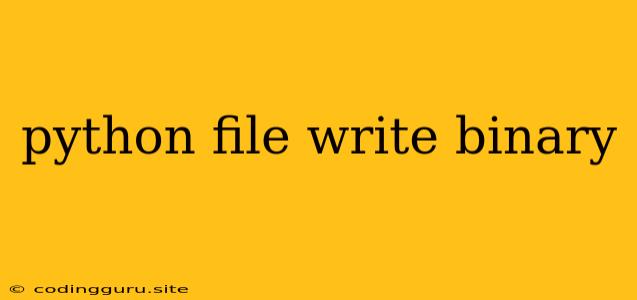Writing Binary Data to Files in Python: A Comprehensive Guide
Python's versatility extends to handling binary data, making it ideal for tasks involving images, audio, video, and other file formats that store information in binary form. In this guide, we'll delve into the intricacies of writing binary data to files using Python.
Understanding Binary Files
Binary files store data in a format that's directly interpretable by computers, unlike text files that represent data as human-readable characters. Think of a JPEG image or an MP3 music file – they're essentially raw binary data.
The "wb" Mode: Your Key to Binary Writing
Python's built-in open() function is the gateway to working with files. When writing binary data, you must specify the "wb" mode in the open() function. This mode tells Python that you're dealing with a binary file and that the data should be written in its raw binary form.
Example: Writing Binary Data
Let's illustrate the process with an example. Imagine you have a list of integers that you want to save as binary data to a file named "data.bin":
data = [10, 20, 30, 40, 50]
# Open the file in binary write mode ("wb")
with open("data.bin", "wb") as file:
# Convert each integer to bytes using struct.pack
for item in data:
file.write(struct.pack("i", item))
In this example, we use the struct module to pack the integers into binary format. The "i" format specifier tells struct.pack to interpret each integer as a 4-byte signed integer.
Reading Back the Binary Data
Reading back the binary data is equally straightforward:
import struct
# Open the file in binary read mode ("rb")
with open("data.bin", "rb") as file:
# Read the entire contents of the file
data = file.read()
# Use struct.unpack to extract the integers
integers = []
for i in range(0, len(data), 4):
integers.append(struct.unpack("i", data[i:i+4])[0])
# Print the extracted integers
print(integers)
The struct.unpack function takes the binary data and uses the "i" format specifier to extract the integers stored in the file.
Common Pitfalls and Solutions
- Incorrect Mode: Using the wrong mode (e.g., "w" instead of "wb") will result in unexpected behavior or errors. Always remember to use the "wb" mode for binary write operations.
- Data Conversion: Ensure that the data you're writing is properly converted to binary format. Using
struct.packor similar methods is essential for this conversion. - Endianness: If you're dealing with multi-byte data, pay attention to endianness. Python uses little-endian byte order by default, but different systems might have different endianness. If necessary, you can use
struct.packwith the "!" prefix to explicitly specify big-endian byte order.
Advanced Techniques: bytearray and bytes
For more control over binary data, you can use the bytearray and bytes objects.
bytearray: Allows you to modify individual bytes in a mutable array.bytes: Represents an immutable sequence of bytes.
Conclusion
Writing binary data to files in Python empowers you to work with diverse file formats, enabling tasks ranging from image manipulation to audio processing. By understanding the "wb" mode, proper data conversion, and the use of struct, bytearray, and bytes, you gain the tools to seamlessly handle binary data in your Python projects.
